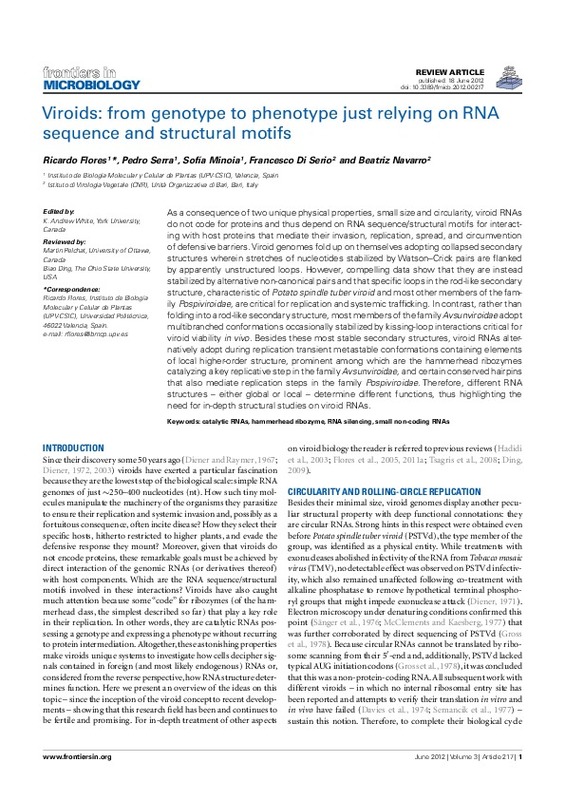JavaScript is disabled for your browser. Some features of this site may not work without it.
Buscar en RiuNet
Listar
Mi cuenta
Estadísticas
Ayuda RiuNet
Admin. UPV
Viroids: from genotype to phenotype just relying on RNA sequence and structural motifs
Mostrar el registro sencillo del ítem
Ficheros en el ítem
| dc.contributor.author | Flores Pedauye, Ricardo
|
es_ES |
| dc.contributor.author | Serra Alfonso, Pedro
|
es_ES |
| dc.contributor.author | Minoia, Sofia
|
es_ES |
| dc.contributor.author | Di Serio, Francesco
|
es_ES |
| dc.contributor.author | Navarro, Beatriz
|
es_ES |
| dc.date.accessioned | 2016-07-19T09:56:09Z | |
| dc.date.available | 2016-07-19T09:56:09Z | |
| dc.date.issued | 2012 | |
| dc.identifier.issn | 1664-302X | |
| dc.identifier.uri | http://hdl.handle.net/10251/67810 | |
| dc.description.abstract | [EN] As a consequence of two unique physical properties, small size and circularity, viroid RNAs do not code for proteins and thus depend on RNA sequence/structural motifs for interacting with host proteins that mediate their invasion, replication, spread, and circumvention of defensive barriers. Viroid genomes fold up on themselves adopting collapsed secondary structures wherein stretches of nucleotides stabilized by Watson Crick pairs are flanked by apparently unstructured loops. However, compelling data show that they are instead stabilized by alternative non canonical pairs and that specific loops in the rod like secondary structure, characteristic of Potato spindle tuber viroid and most other members of the family Pospiviroidae, are critical for replication and systemic trafficking. In contrast, rather than folding into a rod-like secondary structure, most members of the family Avsunviroidae adopt multibranched conformations occasionally stabilized by kissing-loop interactions critical for viroid viability in vivo. Besides these most stable secondary structures, viroid RNAs alternatively adopt during replication transient metastable conformations containing elements of local higher-order structure, prominent among which are the hammerhead ribozymes catalyzing a key replicative step in the family Avsunviroidae, and certain conserved hairpins that also mediate replication steps in the family Pospiviroidae. Therefore, different RNA structures either global or local determine different functions, thus highlighting the need for in-depth structural studies on viroid RNAs. | es_ES |
| dc.description.sponsorship | We thank Dr. J. A. Daros for critical reading and suggestions, Dr. B. Ding for kindly providing Figures 4 and 5, and Dr. M. de la Pena for kindly providing Figure 6. Research in Ricardo FLores laboratory is presently supported by grant BFU2011-28443 from the Ministerio de Educacion y Ciencia (MEC) of Spain. During this work Pedro Serra has been supported by postdoctoral contracts from the Generalitat Valenciana (APOSTD/2010, program VALi+d) and the MEC (program Juan de la Cierva), and Sofia Minoia by a predoctoral fellowship from the MEC. | |
| dc.language | Inglés | es_ES |
| dc.publisher | Frontiers Media | es_ES |
| dc.relation.ispartof | Frontiers in Microbiology | es_ES |
| dc.rights | Reserva de todos los derechos | es_ES |
| dc.subject | Catalytic RNAs | es_ES |
| dc.subject | Hammerhead ribozyme | es_ES |
| dc.subject | RNA silencing | es_ES |
| dc.subject | Small non-coding RNAs | es_ES |
| dc.title | Viroids: from genotype to phenotype just relying on RNA sequence and structural motifs | es_ES |
| dc.type | Artículo | es_ES |
| dc.identifier.doi | 10.3389/fmicb.2012.00217 | |
| dc.relation.projectID | info:eu-repo/grantAgreement/MICINN//BFU2011-28443/ES/VIROIDES: DOMINIOS ESTRUCTURALES, INICIACION DE LA TRANSCRIPCION, INTERACCION CON PROTEINAS ARGONAUTAS DEL HUESPED, Y TASAS DE MUTACION/ | es_ES |
| dc.rights.accessRights | Abierto | es_ES |
| dc.contributor.affiliation | Universitat Politècnica de València. Instituto Universitario Mixto de Biología Molecular y Celular de Plantas - Institut Universitari Mixt de Biologia Molecular i Cel·lular de Plantes | es_ES |
| dc.description.bibliographicCitation | Flores Pedauye, R.; Serra Alfonso, P.; Minoia, S.; Di Serio, F.; Navarro, B. (2012). Viroids: from genotype to phenotype just relying on RNA sequence and structural motifs. Frontiers in Microbiology. 3:217-1-217-13. https://doi.org/10.3389/fmicb.2012.00217 | es_ES |
| dc.description.accrualMethod | S | es_ES |
| dc.relation.publisherversion | http://dx.doi.org/10.3389/fmicb.2012.00217 | es_ES |
| dc.description.upvformatpinicio | 217-1 | es_ES |
| dc.description.upvformatpfin | 217-13 | es_ES |
| dc.type.version | info:eu-repo/semantics/publishedVersion | es_ES |
| dc.description.volume | 3 | es_ES |
| dc.relation.senia | 233396 | es_ES |
| dc.identifier.pmid | 22719735 | |
| dc.identifier.pmcid | PMC3376415 | en_EN |
| dc.contributor.funder | Ministerio de Ciencia e Innovación |








